
© Richardyt / The Paganhill Maypole Society
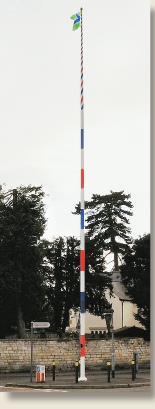



Welcome To The Web Site of The Paganhill Maypole, Gloucestershire, England.
The Paganhill Maypole is maintained wholly from donations from local people and the fund raising activities of the committee of the Paganhill Maypole Society
1929 Stanton Pole
When lowering the 1919 pole on 23 July 1927 for refurbishment it was found to be in such a bad state as to be ‘useless’. Mr Evans, of the newly formed Paganhill Maypole Fund Committee, approach Mr. Arthur W. Stanton, J.P. of Field Place on the matter. He agreed that there must be a new replacement.
Mr Evans was left to make enquiries as to where a new pole might be obtained. Mr. Brunsdon inspected a tree in Woodchester but this was in no way suitable.
A pole was then seen at Bisley by Messrs. Bayliss and Blanch but this was also unsuitable for the purpose. Messrs Stanton and Powell visited a tree at Lypiatt Park which, apparently, was worth considering. Messrs Bayliss and Blanch then heard of a tree on Lord Rothes’ estate near the Royal William and on visiting, it was found to be ideal and at 97 feet, possibly the highest in England.
An offer of £3 was rejected but, Mr. Stanton, who then intervened in the negotiations, finally secured the tree for the £3 following a valuation by a timber haulier. The 2 ton tree was felled in November 1928 and was transported to Paganhill for a further cost of £7 by Mr Brunsdon, all being paid for by Mr.Stanton.
During the following months a ‘whip round’ was held in Paganhill and the adjoining parishes in order to cover setting up and decorating expenses.
On the afternoon of Saturday 27th Sept 1929 a good crowd gathered to witness the putting up of the new maypole which was considered to be the highest in England.
Messrs. Brunsdon expertly hoisted the pole with the assistance of many willing helpers from the committee and bystanders who were much needed to combat the boisterous weather. These included
Messrs. J.Bayliss, T. Blanch, W. Wager,
P. Lusty, W. Powell, C. Stevens, H. Stevens,
W. Lewis, W. Cordy, A. Blick, F. Barratt,
W. Hopkins, C. Collett, H. Horton, W. Burford, J.E.Haynes and others.
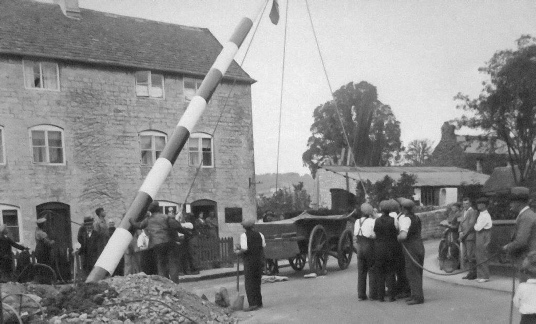
The 1929 pole being slowly raised into position
Mr.Brunsdon charged £4 for re-erecting the pole having sought permission from Col. Stuart, tenent of Upfield House, to park his winch lorry on his grounds so long as the surrounding wall was not damaged.
In 1940 the pole was taken down and stored so that it could not serve as a landmark to enemy aircraft.
The pole was re-erected in 1947 but it did not appear to last long before the timber developed severe decay.
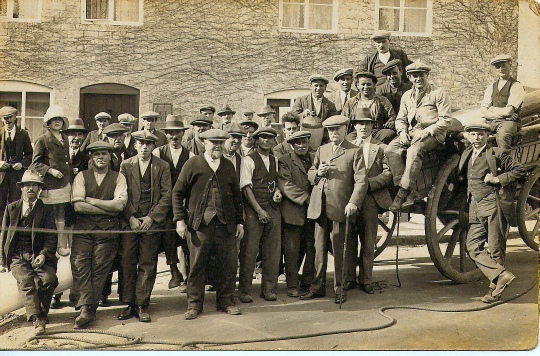
A quick photograph before the raising of the 1929 pole begins
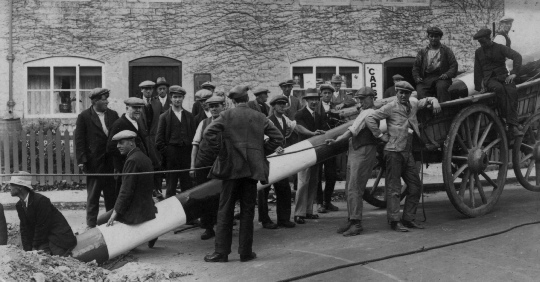
Here the 1929 pole being re-erected after being painted in 1933
The pole stood in its natural state, for four years, to season losing a quarter of its original weight.
It was taken down on 26th August 1933 for painting in the traditional colours of red, white and blue. Mr. Billy Durham proposed that the paint be purchased from Bailey & Co. the quantities being 12 kgs of white and 3kgs each of red and blue.
6 kilos of putty would also be needed together with a quantity of varnish.
It took Mr Wager nearly three weeks to give the pole three separate coats and
Mr. Apperley was contracted to supply the gold leaf to the weather vane.
The 1929 Stanton pole
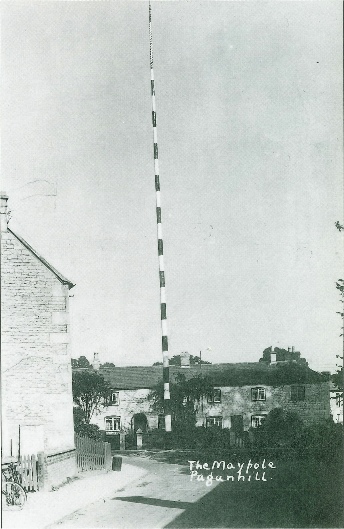 Continue
Continue